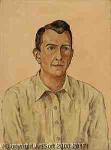Paul Kelpe
Paul Kelpe
Place: Minden
Born: 1902
Death: 1985
Biography:
Paul Kelpe was a German-born American abstract painter. His constructions integrating found objects into paintings were the first such works created in the United States and he painted two of the five Williamsburg murals, the first abstract murals in the United States. In addition to his mural work for various American government projects, he was an innovative independent painter and university art professor. He was a pioneer of American abstract art, including his work in Chicago during a period in which abstracts were not well accepted or appreciated.
Paul Kelpe was born in Minden, Germany on January 15, 1902. After viewing an exhibit of abstract art, Kelpe, who had previously wanted to become a musician, decided instead to pursue a career as a painter. In 1919 he attended the Academy of Arts in Hanover, studying art history and architecture. His artistic training in Germany included studies with Wassily Kandinsky and László Moholy-Nagy, and he encountered art by other modernists including Kurt Schwitters, Naum Gabo, and El Lissitzky. He became familiar with prominent European modernist movements of the time such as Suprematism and Constructivism. Schwitters in particular proved to be a major influence, but Kelpe, eschewing what he viewed as Schwitters' disorderly style, created neater works, meticulously painting geometric shapes without noticeable brushstrokes. His work of this period depicted hard-edged planes and shapes which overlapped and interpenetrated, and he conceived of his paintings as an "organization of forms, not objects of nature". Kelpe said that his parents were not pleased with these abstractions, and they sent him to the United States, hoping that might help to set him on the correct artistic path.
He left Germany for the United States in 1925, staying in New Jersey and New York City. During this period, he integrated found objects into his paintings, resulting in works containing two- and three-dimensional elements. Kelpe was the first artist to create such combine paintings in the United States. His constructions "show a keen formal understanding and playful wit". In the early 1930s he moved on from this assemblage technique; rather than incorporating physical objects into his works, he instead began painting mechanical parts such as wheels and gears into his abstractions. A reviewer noted that Kelpe's "hard-edged geometric paintings ... celebrate the harmony of man and machine".
In 1930 he moved to Chicago, where he was employed as a Works Progress Administration muralist. Kelpe was seen as a bit of an anomaly because of his commitment to abstract art while the Chicago art scene was still firmly centered on Realism. He was the only abstract artist covered in a 1932 book detailing modern art in Chicago. Kelpe's first solo show was in 1931 or 1932 at Chicago's Little Gallery. He wrote that this was "the first time that any one-man shows of abstract art took place in Chicago."
He began work in 1934 painting murals for the Chicago branch of the Public Works of Art Project. As this project was largely concerned with American scene painting and was not open to abstract art, Kelpe included representational images such as buildings and wheels in his designs. His images, products of his imagination rather than any real world industrial site, incorporated a balance of shapes in various sizes and colors. He depicted the American factory as "a Bauhaus-inspired arrangement of geometric machinery". In spite of his efforts to conform to the representational requirements of the job, his mural compositions still received criticism because they were too abstract.
In 1935 Kelpe worked for the Federal Art Project. He created a representational American scene mural for the Southern Illinois University library, History of Southern Illinois, depicting the area's industrial, agricultural, and commercial history.
Feeling stifled by the attitudes so strongly favoring realist art, and desiring an atmosphere which would be more accepting of his abstract sensibilities, Kelpe relocated to New York in about 1935. He gained American citizenship the next year.
In 1936–1937, Kelpe painted two large abstract murals for Brooklyn's Williamsburg Housing Project after being hired by Burgoyne Diller for the New York City Works Progress Administration Mural Program of the Federal Art Project. Diller had selected the artists to participate in the Williamsburg mural project. In addition to Kelpe's two murals, Ilya Bolotowsky, Albert Swinden and Balcomb Greene each created one.
Kelpe's detailed murals, which include various geometric shapes such as triangles, rectangles, trapezoids, and circles, differ from the others in the project by their unique color juxtapositions, their striped, gridded, or bubbled patterns, and their sculpture-like structures. A critic for New York magazine writes that Kelpe's work "looks best of all; his allegiance to Synthetic Cubism may have weighted favor against him at the time, but now his pair of canvases seem masterly in their subtle balance of oranges and greens, and their purely abstract hints of Picassoid guitars – real jazz-age exuberance." The murals, owned by the New York City Housing Authority, are on loan to the Brooklyn Museum.
More...
Wikipedia link: Click Here



